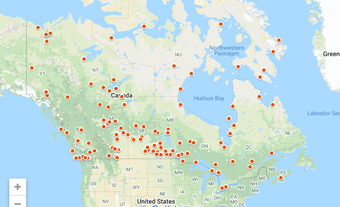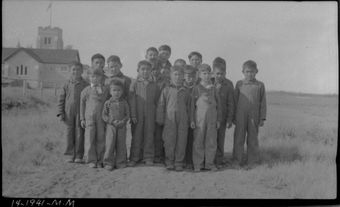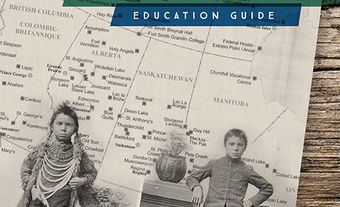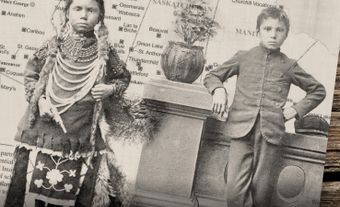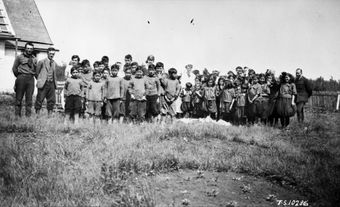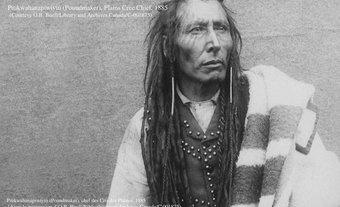Residential schools were government-sponsored religious schools that were established to assimilate Indigenous children into Euro-Canadian culture. Although the first residential facilities were established in New France, the term usually refers to schools established after 1880. Residential schools were created by Christian churches and the Canadian government as an attempt to both educate and convert Indigenous youth and to assimilate them into Canadian society. However, the schools disrupted lives and communities, causing long-term problems among Indigenous peoples. The last residential school closed in 1996. (Grollier Hall, which closed in 1997, was not a state-run residential school in that year.) Since then, former students have demanded recognition and restitution, resulting in the Indian Residential Schools Settlement Agreement in 2007 and a formal public apology by Prime Minister Stephen Harper in 2008. In total, an estimated 150,000 First Nation, Inuit, and Métis children attended residential schools. (See also Inuit Experiences at Residential School and Métis Experiences at Residential School.)
This is the full-length entry about residential schools in Canada. For a plain language summary, please see Residential Schools in Canada (Plain Language Summary).

Key Facts About Residential Schools
| What were residential schools? | Residential schools were government-sponsored schools run by churches. |
| What was the purpose of residential schools? | The purpose of residential schools was to educate and convert Indigenous youth and to assimilate them into Canadian society. |
| How many students attended residential schools? | An estimated 150,000 children attended residential schools. |
| How many children died at residential schools? | An estimated 6,000 children died at residential schools (records are incomplete). |
| How many residential schools were there in Canada? | In total, over 130 residential schools operated in Canada between 1831 and 1996.
In 1931, there were 80 residential schools operating in Canada. This was the most at any one time. |
| When did the first residential school in Canada open? | The Mohawk Institute in Brantford, Ontario, accepted its first boarding students in 1831. |
| When did the last residential school in Canada close? | The Gordon Residential School in Punnichy, Saskatchewan, closed in 1996. It was the last federally-funded residential school in Canada. |
Early Residential Schools in New France and Upper Canada
Residential schools have a long history in Canada. The first residential facilities were developed in New France by Catholic missionaries to provide care and schooling. However, colonial governments were unable to force Indigenous people to participate in the schools, as First Nations people were largely independent and Europeans depended on them economically and militarily for survival.
However, residential schools became part of government and church policy from the 1830s on, with the creation of Anglican, Methodist, and Roman Catholic institutions in Upper Canada (Ontario). The oldest continually operating residential school in Canada was the Mohawk Institute in what is now Brantford, Ontario. This began as a day school for Six Nations boys, but in 1831 it started to accept boarding students. These colonial experiments set the pattern for post-Confederation policies.
Residential Schools After 1880
Beginning in the 1870s, both the federal government and Plains Nations wanted to include schooling provisions in treaties, though for different reasons. Indigenous leaders hoped Euro-Canadian schooling would help their young to learn the skills of the newcomer society and help them make a successful transition to a world dominated by the strangers. With the passage of the British North America Act in 1867, and the implementation of the Indian Act (1876), the government was required to provide Indigenous youth with an education and to assimilate them into Canadian society.
The federal government supported schooling as a way to make First Nations economically self-sufficient. Their underlying objective was to decrease Indigenous dependence on public funds. The government therefore collaborated with Christian missionaries to encourage religious conversion and Indigenous economic self-sufficiency. This led to the development of an educational policy after 1880 that relied heavily on custodial schools. These were not the kind of schools Indigenous leaders had hoped to create.
Beginning with the establishment of three industrial schools on the prairies in 1883, and through the next half-century, the federal government and churches developed a system of residential schools that stretched across much of the country. Most of the residential schools were in the four Western provinces and the territories, but there were also significant numbers in northwestern Ontario and in northern Québec. New Brunswick and Prince Edward Island had no schools, apparently because the government assumed that Indigenous people there had been assimilated into Euro-Canadian culture.
At its height around 1930, the residential school system totalled 80 institutions. The Roman Catholic Church operated three-fifths of the schools, the Anglican Church one-quarter and the United and Presbyterian Churches the remainder. (Before 1925, the Methodist Church also operated residential schools; however, when the United Church of Canada was formed in 1925, most of the Presbyterian and all the Methodist schools became United Church schools.)
Isolation and Assimilation
Overall, students had a negative experience at the residential schools, one that would have lasting consequences. Students were isolated and their culture was disparaged or scorned. They were removed from their homes and parents and were separated from some of their siblings, as the schools were segregated according to gender. In some cases, they were forbidden to speak their first language, even in letters home to their parents. The attempt to assimilate children began upon their arrival at the schools: their hair was cut (in the case of the boys), and they were stripped of their traditional clothes and given new uniforms. In many cases they were also given new names. Christian missionary staff spent a lot of time and attention on Christian practices, while at the same time they criticized or denigrated Indigenous spiritual traditions.
Daniel Kennedy (Ochankuga’he) described his experience at the Qu’Appelle (Lebret) residential school in his memoirs, published as Recollections of an Assiniboine Chief (1972):
In 1886, at the age of twelve years, I was lassoed, roped and taken to the Government School at Lebret. Six months after I enrolled, I discovered to my chagrin that I had lost my name and an English name had been tagged on me in exchange… “When you were brought here [the school interpreter later told me], for purposes of enrolment, you were asked to give your name and when you did, the Principal remarked that there were no letters in the alphabet to spell this little heathen’s name and no civilized tongue could pronounce it.
‘We are going to civilize him, so we will give him a civilized name,’ and that was how you acquired this brand new whiteman’s name.’” …In keeping with the promise to civilize the little pagan, they went to work and cut off my braids, which, incidentally, according to the Assiniboine traditional custom, was a token of mourning — the closer the relative, the closer the cut. After my haircut, I wondered in silence if my mother had died, as they had cut my hair close to the scalp. I looked in the mirror to see what I looked like. A Hallowe’en pumpkin stared back at me and that did it. If this was civilization, I didn’t want any part of it. I ran away from school, but I was captured and brought back. I made two more attempts, but with no better luck.
Realizing that there was no escape, I resigned myself to the task of learning the three Rs. …visualize for yourselves the difficulties encountered by an Indian boy who had never seen the inside of a house; who had lived in buffalo skin teepees in winter and summer; who grew up with a bow and arrow.
(Daniel Kennedy (Ochankuga’he), former student at Qu’Appelle residential school)
Life at Residential Schools
Until the late 1950s, residential schools operated on a half-day system, in which students spent half the day in the classroom and the other at work. The theory behind this was that students would learn skills that would allow them to earn a living as adults. However, the reality was that work had more to do with running the school inexpensively than with providing students with vocational training.
Tasks were separated by gender. Girls were responsible for housekeeping (cooking, cleaning, laundry, sewing), while boys were involved in carpentry, construction, general maintenance and agricultural labour. Funding was a pressing concern in the residential school system. From the 1890s until the 1950s, the government tried constantly to shift the burden of the system onto the churches and onto the students, whose labour contributed financially to the schools. By the 1940s, it was clear to many that the half-day system had failed to provide residential students with adequate education and training. However, the half-day system was not eliminated until the late 1950s, when more funding became available owing to a strong economy.

Daily Routine at Residential Schools
School days began early, usually with a bell that summoned students to dress and attend chapel or mass. Students then performed chores (usually referred to as “fatigue” duty) before breakfast. Breakfast, like all meals, was spartan, and eaten quickly in a refectory or dining hall. This was followed by three hours of classes or a period of work before breaking for lunch. The afternoon schedule followed a similar pattern, including either classes or work, followed by more chores before supper. Time was also set aside for recreation, usually in the afternoon or evening. Some schools had small libraries, while many schools offered organized sports as well as musical instruction, including choirs and brass bands. The evening closed with prayer, and bedtime was early. It was a highly regimented system.
On weekends there were no classes, but Sunday usually meant more time spent on religious practices. Until the 1950s, holidays for many of the students included periods of work and play at the school. Only from the 1960s on did the schools routinely send children home for holidays. Therefore, many students in the residential school system did not see their family for years.
Daily Schedule at Qu’Appelle Industrial School, 1893
(Source: Annual Report of the Department of Indian Affairs, 1893, 173–74; reproduced in Canada’s Residential Schools: The Final Report of the Truth and Reconciliation Commission of Canada [2015], vol. I, p 296)
| 5.30 | Pupils rise |
| 6.00 | Chapel [religious service] |
| 6.30–7.15 | Bedmaking, washing, milking and pumping |
| 7.15–7.30 | Inspection of pupils in the school rooms to see if they are clean and properly dressed, their condition, health & c., a note being taken of those requiring attention, if of clothes, this is done by the sister directly after dinner |
| 7.30 | Breakfast |
| 8.00–9.00 | Fatigue [chores] for small boys |
| 8.00 | Trade boys go to work |
| 9.00–12.00 | School with 15 minutes recess. |
| 12.00–12.10 | Prepare for dinner [lunch] |
| 12.10–12.40 | Dinner [lunch] |
| 12.40–2.00 | Recreation |
| 2.00–4.00 | School and Trades |
| 4.45–6.00 | Fatigue [chores], such as milking, carrying coal, ashes, filling tanks, wood boxes, pumping, sweeping |
| 6.00–6.10 | Prepare for supper |
| 6.10–6.40 | Supper |
| 6.40–8.00 | Recreation |
| 8.00 | Prayer and retire [to bed] |
Education and Vocational Training at Residential Schools
Overall, students received a poor education at the residential schools. This was true both in terms of academic subjects and vocational training. Students had to cope with teachers who were usually ill-prepared, and curricula and materials derived from and reflecting an alien culture. Lessons were taught in English or French, languages that many of the children did not speak. In the workplace, the overseers were often harsh, and the supposed training purpose of the work was limited or absent.
The final report of the Truth and Reconciliation Commission, published in 2015, outlined several “undeniable” conclusions about the system:
- First, the federal government failed to set clear goals and standards for education at the residential schools.
- Second, the curriculum at residential schools was essentially an elementary curriculum, which reflected a belief that Indigenous people were intellectually inferior.
- Third, the government did not develop or implement a policy regarding teacher qualification.
- Fourth, the teaching staff was, in general, underqualified, overworked and poorly paid.
- Fifth, the curriculum (which emphasized the “four Rs” — reading, writing, arithmetic and religion) was not only basic but also largely irrelevant to the students’ needs, experiences or interests.
- Sixth, students left school without the skills they needed to either succeed in their home communities or in the “broader labour market.” Moreover, many of them left without completing their education.
In short, the education and vocational training provided by residential schools was inadequate.
Between Two Worlds: Assimilation and Loss of Culture
Moreover, the attempted assimilation of Indigenous students left them disoriented and insecure, with the feeling that they belonged to neither Indigenous nor settler society.
John Tootoosis, who attended the Delmas boarding school (also known as the Thunderchild school) in Saskatchewan, was blunt in his assessment of the residential school system:
[W]hen an Indian comes out of these places it is like being put between two walls in a room and left hanging in the middle. On one side are all the things he learned from his people and their way of life that was being wiped out, and on the other side are the whiteman’s ways which he could never fully understand since he never had the right amount of education and could not be part of it. There he is, hanging in the middle of two cultures and he is not a whiteman and he is not an Indian.
They washed away practically everything from our minds, all the things an Indian needed to help himself, to think the way a human person should in order to survive.
(John Tootoosis, former student at Delmas school)
Abuse at Residential Schools
Many students suffered abuse at residential schools. Impatience and correction often led to excessive punishment, including physical abuse. In some cases, children were heavily beaten, chained or confined.
Some of the staff were sexual predators, and many students were sexually abused. When allegations of sexual abuse were brought forward — by students, parents or staff — the response by government and church officials was, at best, inadequate. The police were seldom contacted, and, even if government or church officials decided that the complaint had merit, the response was often simply to fire the perpetrator. At other times, they allowed the abuser to keep teaching.
Health, Death and Disease at Residential Schools
According to the Truth and Reconciliation Commission (TRC), at least 3,200 Indigenous children died in the overcrowded residential schools. Due to poor record-keeping by the churches and federal government, it is unlikely that we will ever know the total loss of life at residential schools. However, according to TRC Chair, Justice Murray Sinclair, the number may be more than 6,000.
Underfed and malnourished, the students were particularly vulnerable to diseases such as tuberculosis and influenza (including the Spanish flu epidemic of 1918–19). Food was low in quantity and poor in quality, in large part due to concerns about cost. Faced with limited funding, schools were instructed to observe “the strictest economy… in all particulars.” In general, school menus seem to have been both monotonous and nutritionally inadequate. According to Basil Johnston, who attended the residential school in Spanish, Ontario, he was served “mush, mush, mush, sometimes lumpy, sometimes watery, with monotonous regularity every Monday, Wednesday, Friday and Saturday.”
Menu for the Qu’Appelle, North-West Territories, Industrial School, 1893
(Source: Annual Report of the Department of Indian Affairs, 1893, 174; as quoted in Canada’s Residential Schools: The Final Report of the Truth and Reconciliation Commission of Canada [2015], vol. I, p. 491)
| Breakfast | Four days in the week porridge of oatmeal or cornmeal with either milk or syrup, this is served with hot tea and bread; the working pupils, and those not in robust health, receive butter in addition.
On three days all the pupils receive butter and cheese with their bread instead of porridge, this is served with hot tea. |
| Dinner [lunch] | Soup, meat or fish, vegetables and bread ad libitum [i.e., not regulated]. For dessert, rice or stewed apples, or stewed rhubarb or syrup, or bread and milk, with cold water to drink, excepting to the weak children, and those working outside, who get hot tea. |
| Supper | Meat for the working pupils, hashed meat and vegetables for the rest, bread ad libitum and dessert similar to that named for dinner, hot tea. |
Moreover, research by food historian Ian Mosby (published in 2013) revealed that students at some residential schools in the 1940s and 1950s were subjected to nutritional experiments without their consent or the consent of their parents. These studies were approved by various federal government departments and conducted by leading nutrition experts. They included restricting some students’ access to essential nutrients and dental care in order to assess the effect of improvements made to the diet of other students. Overall, the experiments do not seem to have resulted in any long-term benefits.
Nutritional deficiencies and overcrowding led to regular outbreaks of diseases at the schools. Tuberculosis and influenza were the major killers, but students were also affected by outbreaks of smallpox, measles, typhoid, diphtheria, pneumonia and whooping cough. In the winter of 1926–27, for example, 13 children died from a combination of measles and whooping cough at the Lytton school. Louise Moine, who attended the Qu’Appelle school in the North-West Territories, remembered one year in the early 20th century when tuberculosis was “on the rampage”:
There was a death every month on the girls’ side and some of the boys went also. We were always taken to see the girls who had died. The Sisters invariably had them dressed in light blue and they always looked so peaceful and angelic. We were led to believe that their souls had gone to heaven, and this would somehow lessen the grief and sadness we felt in the loss of one of our little schoolmates. There would be a Requiem Mass in the chapel. We would all escort the body, which was lying in a simple handmade coffin, to the graveyard which was located close to the R.C. [Roman Catholic] Church in the village.
(Louise Moine, former student at Qu’Appelle residential school)
Although medical experts such as Dr. Peter Bryce, Dr. James Lafferty, Dr. O.I. Grain and Dr. E.L. Stone recommended measures to improve health and medical treatment, these were not implemented by the government, largely due to concerns about cost and opposition by the churches.
The schools could have helped children to reduce their vulnerability to tuberculosis by providing them with sanitary, well-ventilated living quarters, an adequate diet, warm clothing, and sufficient rest. Rather, the residential schools regularly failed to provide the healthy living conditions, nutritious food, sufficient clothing, and physical regime that would prevent students from getting sick in the first place, and would allow those who were infected a fighting chance at recovery.
(Canada’s Residential Schools: The Final Report of the Truth and Reconciliation Commission of Canada [2015], vol. I, p. 451)
Resistance and Closure
Indigenous students and parents resisted and protested the harsh regime in place at most residential schools. Some children refused to co-operate and sabotaged the operations of the kitchen or classroom, stole food and supplies, or ran away (as did Chanie Wenjack in 1966). At least 25 fires were set by students as a form of protest. Their parents and political leaders protested the schools' harsh conditions and pedagogical shortcomings, though their objections were mostly ignored.
By the 1940s it was obvious to both the government and most missionary bodies that the schools were ineffective, and Indigenous protests helped to secure a change in policy. In 1969, the system was taken over by the Department of Indian Affairs, ending church involvement. The government decided to phase out the schools, but this met with resistance from the Catholic Church, which felt that segregated education was the best approach for Indigenous children. Some Indigenous communities also resisted closure of the schools, arguing either that denominational schools should remain open or that the schools should be transferred to their own control. By 1986, most schools had either been closed or turned over to local bands. Ten years later, Gordon Residential School in Punnichy, Saskatchewan, finally closed its doors.
Ground-Penetrating Radar Searches
In May of 2021, Tk'emlúps te Secwépemc First Nation in British Columbia hired a team of specialists to conduct ground-penetrating radar searches on the grounds of the former Kamloops Indian Residential School. They detected ground disturbances, and later concluded that these were 200 “possible burials” at the site.
In operation by the Catholic Church from 1890 to 1969, the Kamloops Indian Residential School reported having up to 500 children registered each year, according to the National Centre for Truth and Reconciliation (NCTR). The 2008 TRC was told that only 50 deaths had occurred at the institution. The school officially closed in 1978 after the federal government took over control in 1969.
There have been findings using ground penetrating technologies at few residential school sites due to the sensitive process and impact on communities. It is presumed that historical records pertaining to deaths at the institutions are flawed due to some Catholic orders withholding statistics on the institutions. As a result, similar findings, such as those at the Kamloops Indian Residential School could occur in the future.
Recovery, Reparations, and Reconciliation
Indigenous communities, often with church support, and since 1998 with government financial assistance, have been carrying out the difficult work of supporting their members with the long-term impact of residential schools, including family breakdowns, violence and aimlessness. Beginning in the late 1990s, former students demanded that government and churches publicly acknowledge their role in the schools and provide compensation for their suffering.
In 2005, the federal government established a $1.9 billion compensation package for the survivors of abuse at residential schools. In 2007, the federal government and the churches that had operated the schools agreed to provide financial compensation to former students under the Residential Schools Settlement Agreement.
On 11 June 2008, Prime Minister Stephen Harper, on behalf of the Government of Canada, offered an apology to all former students of residential schools in Canada. The apology openly recognized that the assimilation policy on which the schools were established was "wrong, has caused great harm, and has no place in our country." The apology recognized the profoundly damaging and lasting impact the schools had on Indigenous culture, heritage and language and was one of the steps that the government has taken to forge a new relationship with Indigenous peoples in Canada.
Harper’s apology and the compensation packages offered by the federal government excluded survivors of residential schools in Newfoundland and Labrador. Since Canada did not establish or operate residential schools in that province (Newfoundland was not part of Canada at the time the schools began operating), the federal government argued that it was not responsible for compensating former students. After survivors launched a class-action lawsuit against the government, a settlement of $50 million was reached on 10 May 2016. The settlement was approved by Newfoundland and Labrador Supreme Court Justice Robert Stack on 28 September 2016. On 24 November 2017, Prime Minister Justin Trudeau formally apologized to survivors of residential schools in Newfoundland and Labrador.
In 2020, the federal government announced it is designating two former residential schools — Shubenacadie Residential School in Nova Scotia and Portage La Prairie Residential School in Manitoba — as national historic sites. The government is also recognizing the residential school system as an event of historic significance in Canada. (See also Reconciliation in Canada.)
On 3 June 2021, the federal government recognized every 30 September annually as the National Day for Truth and Reconciliation. The day honours the survivors of residential schools as well as their families. Another commemorative day, Orange Shirt Day, is also held every year on 30 September. Orange Shirt Day began in 2013 and was inspired by residential school survivor Phyllis Webstad. On her first day of school, Webstad wore an orange shirt that was taken from her by the school authorities and never given back. Orange shirts are worn to commemorate all those children who had their culture taken from them.
In September 2021, Queen Elizabeth II commemorated Canada’s first National Day for Truth and Reconciliation by saying, "I join with all Canadians on this first National Day for Truth and Reconciliation to reflect on the painful history that Indigenous peoples endured in residential schools in Canada, and on the work that remains to heal and to continue to build an inclusive society.” As Canada’s head of state, the Queen is being asked to formerly apologize for the Crown’s role in the operation of residential schools.
Pope Francis formally apologized for the Catholic Church’s involvement in residential schools in March 2022. The Pope asked forgiveness “for the deplorable conduct of those members of the Catholic Church” who were involved in the residential school system. A delegation of Indigenous peoples who went to Rome to speak with the Pope heard the historic apology in person. Cassidy Caron, the leader of the Métis National Council said that “an apology is one step forward, but there is more work to be done.” In July 2022, the Pope travelled to Canada and offered an apology on Canadian soil. He said, “I humbly beg forgiveness for the evil committed by so many Christians against the Indigenous peoples.” The Pope acknowledged that his apology is only a step toward making amends and that an investigation must be conducted into the events of the past. Many have called on the church for financial compensation as well as other forms of reconciliation, including the return of Indigenous artifacts, the release of school records, and the overturning of the Doctrine of Discovery.
Did You Know?
Historica Canada, using data supplied by the National Centre for Truth and Reconciliation at the University of Manitoba, has created a map (see below) of all residential schools in Canada. Part of a larger effort by Historica Canada called the Residential Schools Awareness Program, the map includes the location, name, religious denomination, opening and closing dates, and any other names by which the schools were known.
Names of Children Who Died in Residential Schools Released
On 30 September 2019, the names of 2800 children who died in residential schools in Canada were released by the National Centre for Truth and Reconciliation in a ceremony in Gatineau, Quebec (see Truth and Reconciliation Commission). The ceremony was the culmination of years of archival research of government and church records dealing with Indigenous children in 80 schools across the country, with records going back as far as the 1890s. According to archivists, another 1600 children who died in residential schools remain unnamed, and researchers continue to pore over records to discover their identities.
The names and schools of the children were displayed on a huge 47-metre long, blood-red cloth banner. Tia-o-qui-aht First Nation Elder Dr. Barney Williams, a residential school survivor and member of the Indian Residential School Survivor Committee (an advisory body to the Truth and Reconciliation Commission), believes that the ceremony was important to ensure that the children who died are not forgotten: “Today is a special day not only for myself but for thousands of others, like me, across the country to finally bring recognition and honour to our school chums, to our cousins, our nephews, to our nieces that were forgotten.” To Elder Williams, the unveiling of the 2800 names was a “heartwarming” and “very emotional” moment for himself and thousands of Indigenous families across Canada.

 Share on Facebook
Share on Facebook Share on X
Share on X Share by Email
Share by Email Share on Google Classroom
Share on Google Classroom

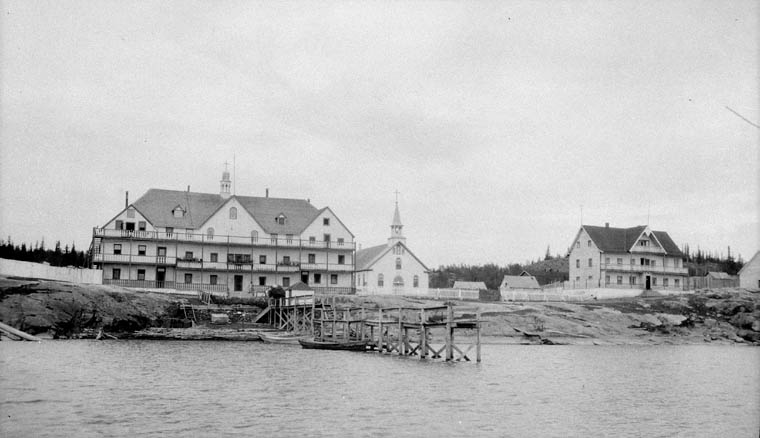

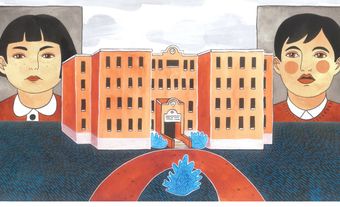
.jpg)
